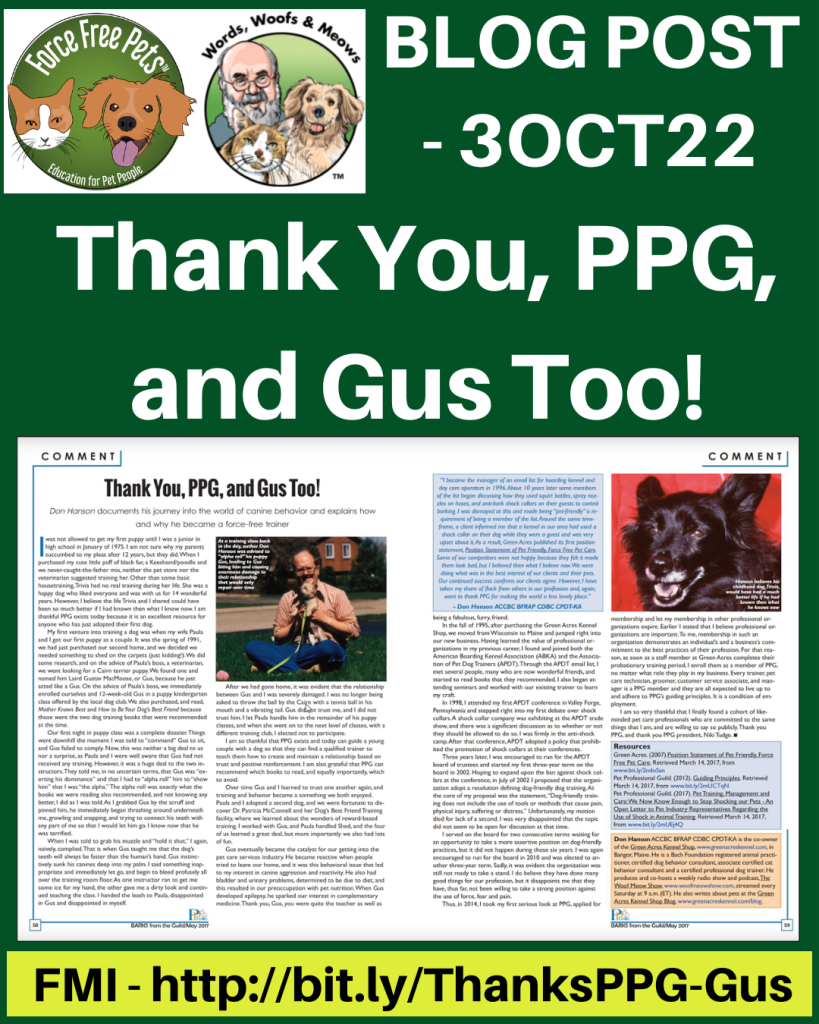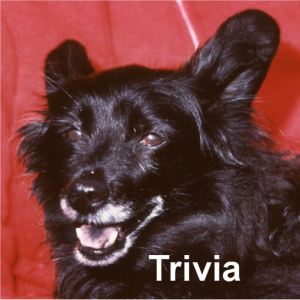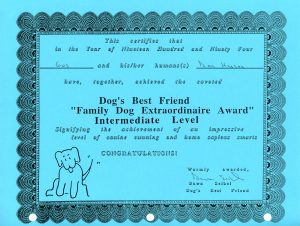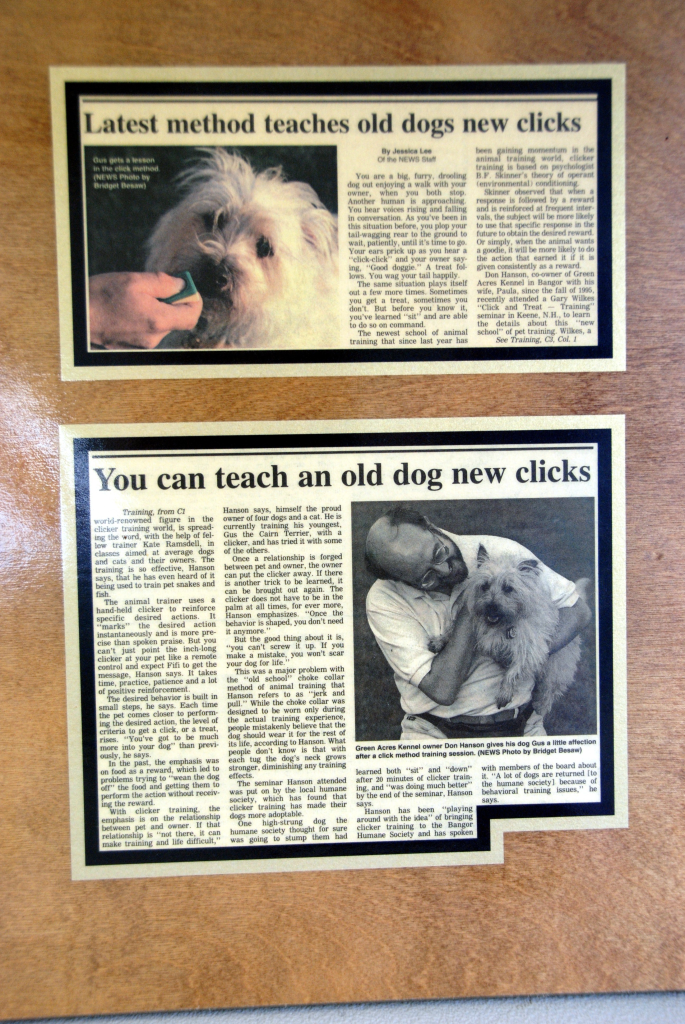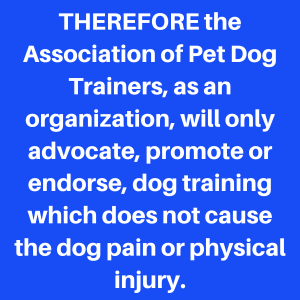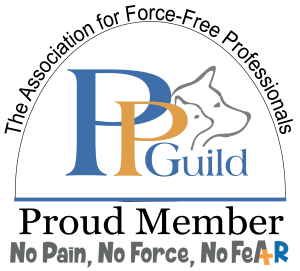< A version of this article was published in the FEB 2021 issue of Downeast Dog News>
< A short link for this page – http://bit.ly/ThankYouTrivia-Gus >
January marks the anniversaries of two of the dogs that have been part of my life. They have both passed, but there is not a day I do not think about them or acknowledge how they helped me to become a better dog trainer and a better person.
Trivia – I had wanted a dog since I was five years old. My parents finally succumbed when I was 17. I found a puppy at a pet store that was described as “A Poodle/Keeshond mix, and they never found the father.” I didn’t care about the breed; I just wanted a dog. Trivia had wavy hair and was as excited to see me as I was to see her. It was love at first sight. I left the pet shop with her, a collar, a leash, food and water bowls, a couple of toys, a rawhide, and the name of the veterinarian recommended by the pet shop. I was thirty plus dollars poorer but felt like the richest guy on the planet.
breed; I just wanted a dog. Trivia had wavy hair and was as excited to see me as I was to see her. It was love at first sight. I left the pet shop with her, a collar, a leash, food and water bowls, a couple of toys, a rawhide, and the name of the veterinarian recommended by the pet shop. I was thirty plus dollars poorer but felt like the richest guy on the planet.
Why my parents let me get a dog at this point in our lives, I will never know. I suspect it had something to do with the fact that we had lost my older sister to a brain tumor just days before Christmas. Looking back, their decision makes even less sense, as my dad was scheduled to retire in two months, and they planned on traveling. I was a junior in high school, active in many extracurricular activities, and had a girlfriend. You know what happened and who did most of the work of caring for Trivia the first few years of her life. My mom. Thank you, mom and dad, for your crazy decision to let me get a dog. It was clearly based on love with no logic involved.
In 1977 I knew nothing about training a dog or the benefits of training a dog, and no one suggested I train Trivia. I regret I did not know then what I know now as I believe I could have made Trivia’s life so much better. Trivia inspires me to help my clients and students do all they can for their furry companions. Thank you, Trivia; you were small but were in no way trivial. [ FMI – http://bit.ly/TriviaNOV74AUG89 ]
Gus (Laird Gustav MacMoose) – Gus was the first puppy Paula and I raised together. He was a Cairn Terrier, and despite our knowing better, we bought him at a pet shop. Most of my friends in the pet care professions believe that we learn 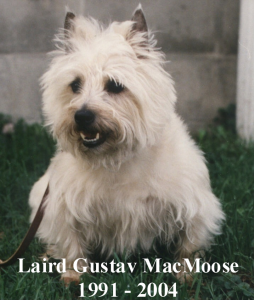 the most from the dogs that are difficult. Paula and I remember Gus as the equivalent of a post-doctoral program.
the most from the dogs that are difficult. Paula and I remember Gus as the equivalent of a post-doctoral program.
- Gus bit me on our first night in puppy class due to my ignorance and the class’s two instructors’ arrogance. That led to my interest in canine behavior and training. [ FMI – http://bit.ly/Things-Gus-Dominance ]
- Gus was the epitome of a silent thief. He walked off with tools from people working in our home and stole food right out of our hands and those of some of our staff. He taught me that the management of a dog and his environment was as crucial as training.
- Within the first few months of his life, Gus developed a chronic urinary tract infection, which caused crystals to form in his urine. His veterinarian felt it was due to nutrition but could offer little advice other than to suggest resources where we could teach ourselves more about his nutritional needs. That led to a lifelong interest in pet nutrition for Paula and me and a commitment to educating others. We eventually found the answer for Gus’ crystals in 1997.[ FMI – http://bit.ly/Gus-Nutrition ]
- Thunderstorms were a significant event for Gus. One to two hours before the thunder and lightning started, he would become agitated. By the time the storm arrived, he was barking and lunging at the door to get outside so he could “kill it.” Most dogs that have issues with thunderstorms want to hide. Not Gus. The medications prescribed by his veterinarian were of no help, nor was the

Don & Gus in 1991, Before the Alpha Roll desensitization CD played at very low levels on a world-class sound system. Gus knew the difference between a real storm and one on the stereo. The closest we came to a cure was moving from Wisconsin to Maine, where thunderstorms were not as frequent.
- Gus started having seizures as he became older, which were diagnosed as idiopathic epilepsy. Like everything else in his life, Gus lived large, even with seizures, each in the Grand Mal category. He was treated for many years with the medications in use at that time. Even then, he would still have a seizure about every ten days. Eventually, we could not increase the dose of his medication without harming his liver. Paula started investigating complementary therapies such as homeopathy and acupuncture. Gus finally found his most significant relief from seizures through acupuncture, which, interestingly, also stooped his reactivity to thunderstorms. Both Paula and I credit Gus for opening our minds to complementary healing modalities that we now use with our pets and ourselves to supplement traditional medicine.
Gus was ultimately the catalyst that caused Paula and me to join the ranks of pet care professionals and to buy Green Acres Kennel Shop. He inspired our interest in behavior, training, nutrition, and complementary healthcare. While there were times, Gus frustrated us beyond belief; there was not a day he did not make us laugh. Thank you, Gus!
Recommended Resources
Articles on Don’s Blog
( http://www.words-woofs-meows.com )
Our Pets – Remembering Trivia (13NOV74 – 04AUG89) – https://bit.ly/TriviaNOV74AUG89
Things I Wish I Had Known Before I Started Training Dogs – Gus, the Dominance Myth, An Alpha Roll, and a Damaged Relationship – http://bit.ly/Things-Gus-Dominance
Pet Nutrition: Some Myths and Facts – Part 1 – My story with Gus – http://bit.ly/Gus-Nutrition
Thank You, PPG, and Gus Too! – http://bit.ly/ThanksPPG-Gus
In Memory of Gus (1991 – 2004) – http://bit.ly/InMemoryOfGus
________________________________________________________________________
Don Hanson is the co-owner of the Green Acres Kennel Shop ( greenacreskennel.com ) in Bangor, Maine, where he has been helping people with their pets since 1995. He is also the founder of ForceFreePets.com, an online educational resource for people with dogs and cats. Don is a Bach Foundation Registered Animal Practitioner (BFRAP), Certified Dog Behavior Consultant (CDBC), Associate Certified Cat Behavior Consultant (ACCBC), and a Certified Professional Dog Trainer (CPDT-KA). He is a member of the Pet Professional Guild (PPG). Don is committed to PPG’s Guiding Principles and the Pain-Free, Force-Free, and Fear-Free training, management, and care of all pets. He serves on the PPG Steering Committee and Advocacy Committee and is the Chair of The Shock-Free Coalition ( shockfree.org ). Don produces and co-hosts a weekly radio show and podcast, The Woof Meow Show, that airs on Z62 Retro Radio WZON (AM620) and WKIT 103.3-HD3 and is streamed at http://bit.ly/AM620-WZON every Saturday at 9 AM. Podcasts of the show are available at http://bit.ly/WfMwPodcasts/, the Apple Podcast app, and Don’s blog: www.words-woofs-meows.com. The opinions in this post are those of Don Hanson.
©07FEB21, Donald J. Hanson, All Rights Reserved
< Click for Copyright and Use Policy >

